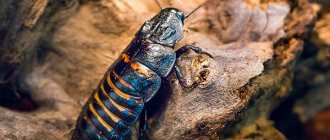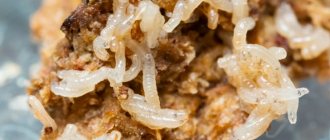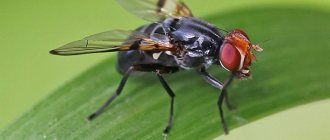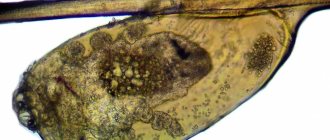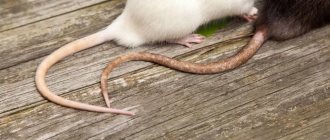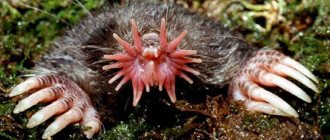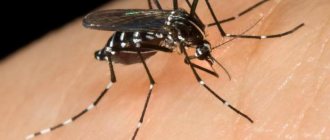Why do they bite us and how does this affect mosquito reproduction?
The fact is that human sweat contains lactic acid; bloodsuckers sense it at a great distance. For this reason, mosquitoes torment people most severely during the hot season. Being bitten, people, without knowing it, encourage the reproduction of mosquitoes and create very comfortable conditions for them. Thanks to the saturation of mosquito females with blood, a new population of viable and strong individuals appears.
Not everyone knows, but mosquitoes reproduce even if they do not bite people or animals. In this case, they have to expend the resources of their own body to form eggs. As a result, the offspring of mosquitoes are born weak, and after laying the insect itself dies. Until the time of laying comes, the female constantly returns to the victim and bites her, after each digestion of blood.
In order to get rid of mosquitoes, you need to start with the original cause of the nuisance: reproduction. Understanding how mating occurs and what individuals eat will help you choose the right place to travel. And avoid many problems. Mosquitoes are harmful to humans, and to effectively combat them, it is helpful to first learn how mosquitoes reproduce.
How mosquitoes get into your home
Just because the doors and windows are closed does not mean that you are completely protected from insects entering your home. There are many loopholes and places where mosquitoes come from in an apartment. Among them:
- through the front door, when it is opened to come in or out, mosquitoes staying in the entrance rush into the apartment, attracted by the light, the smell of a person or warmth;
- on the folds of clothes of people entering from the street;
- cracks in balconies or loggias;
- through the ventilation system;
- holes in mosquito nets.
The appearance of mosquitoes in the house is not related to the arrangement of life and a person’s lifestyle. The specificity of these “guests” always makes them stay close to you. Their number in the house can increase significantly in rainy and warm summers, even if there are mesh on the windows. Blood-sucking parasites move very quickly, so they only need a few seconds to easily penetrate any home.
Go to website
The places where mosquitoes appear can be localized in the room itself. Insects create nests in areas of high humidity. This doesn't have to be the bathroom. Usually these are poorly equipped basements of multi-story or private houses, where it is damp and stagnant all year round. In such “incubators,” entire mosquito populations develop, from where, through the ventilation system, through the elevator shaft and entrance, individual individuals enter the apartment.
Mosquito mating process
- The ideal place for mating is a stagnant body of water; the males accumulate near them and wait for the female.
- Females emit a thin squeak, thereby attracting males, who feel it with the help of their antennae; they make this characteristic sound with their wings.
- Individuals gather in a swarm in which only male mosquitoes move, they drag the female into it and mating occurs.
- The female who finds herself inside the swarm is fertilized by the male mosquito who first grabbed her.
The process lasts a very short time, at the end the mosquito returns to the other males. The internal genital organs are hidden in the body of the mosquito; in females these are the ovaries and ovipositor, in the form of a short tube, and in males these are the testes. Fertilization also occurs internally; during sexual intercourse, mosquito sperm enters the female, into her reproductive tract.
Does a mosquito die after biting a person?
Since male mosquitoes do not bite people, the fact of a bite cannot affect their existence in any way. As for female mosquitoes, they can bite the victim repeatedly, this will not affect their health in any way. Unlike, for example, a bee, which, having stung a person, leaves a sting with part of the body in his skin and dies because of this, a mosquito easily pierces the skin and also easily removes the proboscis, without being injured at all.
The only thing that can affect the lifespan of mosquitoes that attack a person is the speed and dexterity of the victim. A good reaction from a potential victim will help kill an insect that is about to start eating or is already sucking blood.
What happens after the female is fertilized?
The female mosquito feeds on the blood of mammals very actively, as this is required by the process of development and formation of eggs. The male does not have special piercing bristles inside his proboscis, so he remains a vegetarian. With the oral apparatus of a male individual it is simply impossible to bite. In females, the oral apparatus is fully formed, they penetrate the skin and inject into it a special secretion that prevents blood clotting. After mating, females lay eggs on the surface of the water.
There are two ways in which females lay eggs:
- Separately, one egg at a time
- “Packs” of eggs glued together.
Their number is usually from 150 to 400. Female mosquitoes can lay about 1200 eggs during their entire life span. After the breeding process, the male mosquito dies. Females lay eggs every 2-3 days during the active period.
Life expectancy and living conditions of mosquitoes
Blood-sucking insects live in all regions of the world. The most suitable for them are rivers, swamps, other bodies of water - especially with standing water, lowlands, shrubs, and forested areas. Optimal living conditions for mosquitoes:
What blood type do mosquitoes prefer?
- At temperatures up to +15, the life expectancy of an insect is 4 months, at +20 it is halved. The lifespan of a male is 1.5 times less than that of a female.
- High humidity levels promote active reproduction of insects.
- Lack of natural enemies - these include reptiles and various birds.
- Availability of food - males require a sufficient amount of plant nectar, females require human or animal blood.
In such conditions, mosquitoes reproduce at a rapid pace. Under favorable conditions, the female can lay eggs every 3 days.
Stages of mosquito development
Egg
Mosquitoes prefer places with a lot of plant debris, such as muddy banks. For unhindered reproduction, it is important that there are no waves, otherwise the eggs will not hatch. A menacing number of mosquitoes appears at the beginning of summer, when high temperatures set in. After winter, the pupae, which have turned into mosquitoes, quickly begin the mating process. Massive laying of eggs occurs, 20-30 eggs at a time. The warmer the water, the faster the incubation period occurs. It takes at least 40 hours for the eggs to hatch.
Larva
After the eggs hatch, the busy part of the mosquito's life cycle begins. The mosquito larva develops sequentially, in a number of molts. The mosquito larva sheds its outer shell three times during development. Metamorphosis during mosquito development includes four stages. The larvae swim alone in the water and feed on energy very intensely. They have a mouthparts and active brushes inside them. If it is warm around and there are no fry that feed on the larvae, then future mosquitoes grow quickly. This is the most important stage in development. The larvae hang at the very surface of the water in a calm state. Their diet includes a variety of microscopic organisms, unicellular algae, and parts of rotting plants.
Doll
After the larvae reach their maximum size, pupation occurs inside the shell. During this stage of development, mosquitoes do not feed, they develop thanks to the energy reserve that they gained while still being a larva, and the pupae breathe thanks to the tubes that come out. A movable abdomen with a tail extending from the cephalothorax allows it to swim away from danger. The pupa is similar in appearance to a small tadpole; only the abdomen remains free from the shell; the front part of the body is covered with a common shell. The curve of the body is shaped like a comma. The pupa in the water exposes the front end of its body, and not the rear, unlike the larva, and is suspended on the surface. The color of a newborn mosquito is almost black. Pupae that have already matured burst above the water, and adult individuals are born from them. Until the wings dry out and straighten out, the mosquito does not fly into the air, but clings to the pupal shell it has abandoned.
Adult
The last stage in the mosquito's life cycle is the transformation from pupa to adult. They are called imago. The only goal of a sexually mature and fully formed individual is the reproduction of offspring. It is impossible to say exactly how long the life cycle of a mosquito lasts, since this is influenced by the diversity of species, different conditions in which individuals live, it is important how filled the environment is with food for the larvae, the speed of transformation into a pupa depends on this.
Development cycles
Mosquito reproduction is a complex process that requires certain conditions. This includes sufficient blood consumption by the female, survival of larvae in reservoirs, optimal temperature conditions, and, most importantly, the constant presence of a water source.
After fertilization, the female lays eggs on the water surface. These can be stagnant or low-flowing reservoirs. The main thing is that they do not dry out for a long time until the full development cycle of the mosquito occurs.
The eggs, fastened together, float on the water for several days. They do not sink due to surface tension. They feed mainly on bacteria and spores. Then the larvae hatch. They are easy prey for young fish.
To ensure their vital functions, the larvae have a number of adaptations. The eyes are covered with a special case; the digestion process is ensured by an intramuscular pusher. After the larva turns into a pupa, it develops fins and hairs on its abdomen. They are the ones who keep it on the surface of the water.
A complex process occurs inside the cocoon, the result of which is the emergence of an adult mosquito (imago). The skin of the pupa bursts, and first the head comes out through the gap, then the chest, wings and limbs of the insect. The first flight occurs after the wings of the imago have dried and are ready to take off. They move to coastal vegetation.
After turning into adults, mosquitoes are ready to mate and reproduce. Females begin searching for victims. And the whole process is repeated again - from egg to adult imago. The entire development cycle lasts approximately from one week to a month. It all depends on the ambient temperature.
Interesting facts about mosquitoes
When a female chooses a victim, she focuses not only on the smell of lactic acid, but also on carbon dioxide exhaled by a person or any other mammal. Also, the female mosquito reacts to light, preferring dark rooms, which is why they are mainly nocturnal. Males live less time than females, on average 19 days.
Knowing the peculiarities of development and how mosquitoes reproduce, you can begin to take measures to destroy them. The total destruction of mosquitoes is called disinfestation. You can fight insects in both closed and open spaces. It is necessary to cut off oxygen to the larvae. An effective eradication process will include eliminating mosquito populations both outdoors and indoors. It is necessary to eliminate dampness in the premises. Most often, juveniles develop in basements.
Previous post What does the queen of a house ant look like: photo and description
Next entry Black cockroach - how it can be recognized and destroyed
Anatomy
If scientists have not yet fully studied this small insect and quite a lot of questions remain, then all the details regarding their structure are known. At first glance, such a “primitive” creature without any special features is very complex. Their small body has almost all the internal organs of higher mammals.
Regardless of the type of mosquito, they all have similar external signs. They have a small thin body, the length depending on the species reaches 4-14 mm. All individuals have thin, long legs and transparent wings. The narrow wings can have a span from 5 mm to 3 cm, which also depends on the specific species. The color of the body is gray, brown or yellow; there are species that have rare colors, black and green.
The structure of a mosquito is divided into head, chest and abdomen. Individuals have six legs, the abdomen is always smaller in size than the chest. The chest is divided into 10 segments. When blood-sucking animals are saturated, the abdomen swells and increases significantly in size, so in saturated individuals the abdomen is larger than the chest.
